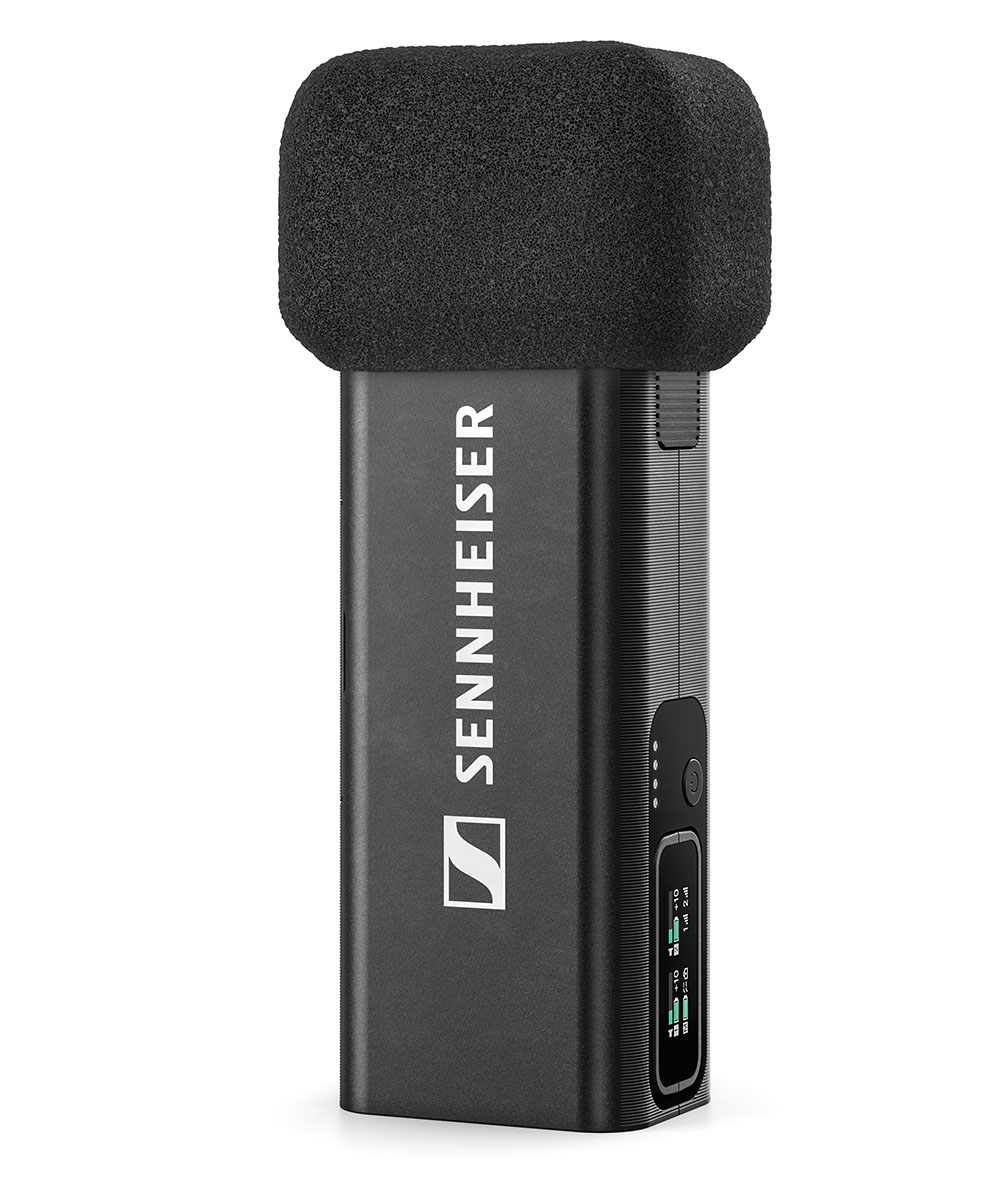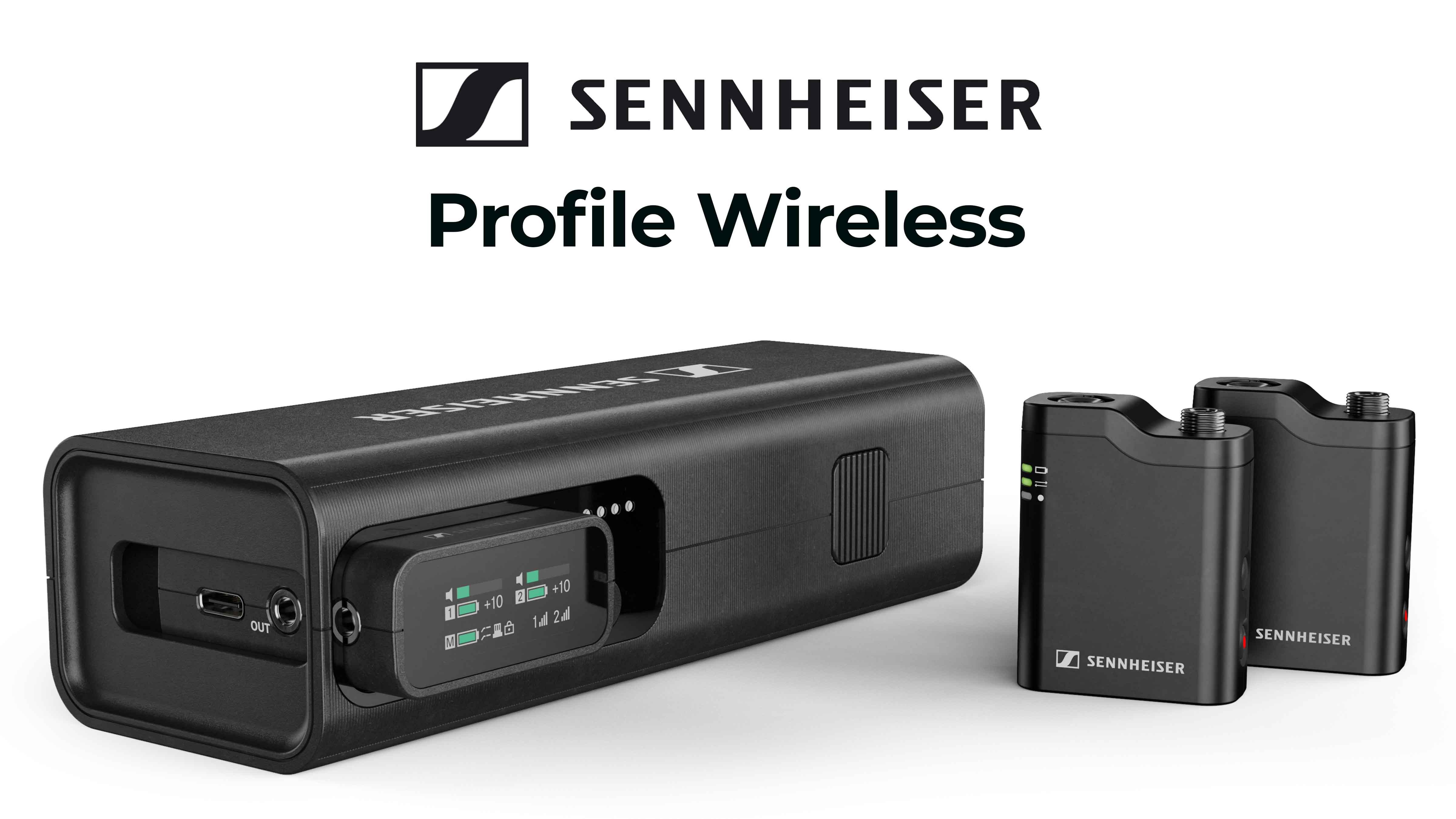From my official Swiss Army Knife to my knockoff Leatherman, I'm a sucker for a good combo tool. Now, Sennheiser has created a sort of sonic multi-tool with its Sennheiser Profile Wireless, a two-channel wireless microphone system that lives in a 6-inch proprietary charging bar and offers surprising flexibility.
Let's start with the mics/transmitters. They are very compact, less than an inch thick and about as tall as two postage stamps (a little larger with the windscreen attached). The mics themselves offer a 60-20,000 Hz frequency response with 48 kHz sampling. You can use the integrated clips or included magnets (which are neatly stored on the charging bar) to position the mics on your talent.
Want a little more versatility, along with a more traditional on-camera look? Each transmitter features a threaded input, so you can use it as a transmitter for a lav with a locking 3.5mm connector, such as Sennheiser's ME 2.
Now comes the combo: The Profile Wireless charging bar can also be used as a handheld mic. Admittedly, it does not match the aesthetic of your typical handheld; it's a rectangle with a rounded windscreen on the business end. But if you find yourself needing to work the crowd instead of conducting a one-on-one interview, you're set. You can even keep wearing one transmitter and use it as your mic while you conduct interviews with the other in the charging case.
And here's a bonus: The Profile Wireless doubles (triples?) as a tabletop mic—just attach a small tripod using the 1/4-inch thread on the bottom of the charging bar. Each transmitter has a thread as well, so they can be mounted separately, if necessary.
Menus and More

The Profile Wireless comes packed in its own soft carrying pouch, which offers some transport protection. The inside cover has two mesh pockets, one dedicated to the two tiny deadcats for the lavs and the other housing the included footlong USB-C cable and 3.5mm coiled cable that comfortably stretches for about a foot as well. I was able to squeeze a set of wired earbuds and a longer USB-C into the main area of the pouch next to the charging case, but it was a tight fit.
Setup is about as easy as it gets. When you first open the unit, you'll need to remove protective films that are over the contacts on the two transmitters and the receiver. Then, the receiver's screen will prompt you to set the time and the date on its touchscreen display, which you accomplish by swiping between pages and tapping. Next comes the pairing—oh wait, the transmitters and receiver are already paired. Told you it was easy.
Three textured buttons on the charging case provide access to the mics and receiver. Press a button and the corresponding piece of equipment "pops" out of place so you can grab it, but not with enough force to actually fall out of the case. It's a nice touch that should prevent the mics from capturing a parade of bad language from audio engineers crawling on the ground to retrieve components.
One side of the charging case houses the USB-C charging port. Around that port is a storage area for three adapters: USB-C, Lightning for older iPhones, and a cold shoe for DSLRs. You'll need these, of course, to integrate with your other equipment.
It might be equipped with a small screen, but the transmitter keeps track of a lot of vital information. You can clearly monitor the levels of both mics, plus battery and signal levels. A red dot indicates if you start recording on either mic.
There is a limited menu of options available on the receiver specifically for the microphones. From here, you can turn on recording, mute the mics (represented via a yellow light on the mic you select), adjust the gain, turn on a low cut filter, and shut off the LEDs on your mics. Swipe right for Mic 1, swipe left for Mic 2. On Mic 1, you swipe left to go back, but it's the opposite (swipe right) for Mic 2.
Swipe up on the receiver and there's a new menu where you can choose recording mode, adjust headphone and output levels, reset pairing, and more. You can also rotate the display, which will be important when you connect the receiver to your iPhone. You can record in mono, which mixes both mics together, stereo, which keeps each mic on its own dedicated channel, or safety, which records one channel at a lower volume as a backup in case of unexpected loudness.
Time to Test
My first test was simple. I plugged the receiver into my iPhone 15, turned on the low-cut filter on one of the mics, clipped it on my shirt, started recording via the Mavis Camera app, and took a walk, leaving the phone and transmitter behind in my office. The Profile Wireless performed admirably—no dropouts, even when I was more than 50 feet away. There's also a backup recording mode, so you can record audio internally just in case.

And the mic itself was impressive. It has an omnidirectional pickup pattern and it picked up everything, including street traffic and my footsteps on the grass. There was a slight breeze, but nothing the windscreen couldn't handle. On a lazy Sunday morning, a rainstorm came though, so I grabbed the Profile Wireless, attached a mic to my blazer lapel with a magnet, and recorded a test on the back porch using the Blackmagic Camera app. Yes, you can hear the rain and even some birds in the background, but my voice is far louder and clearer than any of that.
Another test passed with flying colors: integration with my Canon EOS Rebel T3i, which admittedly is an older camera. It was easy to mount the receiver, and the 3.5mm coiled cable provided a clean connection for recording.
As a handheld, the Profile Wireless was surprisingly comfortable. It feels solid but not too heavy; in fact, the whole system, while mostly plastic, benefits from a professional build quality. A nontraditional look, sure, but it does the job very well and provides a great backup solution if something happens to your primary handheld.
I even used the mic for a few videoconferences. Reviews from the other side of the conversation were positive. The worst comment I got was that my voice could use a little more bass, but that same person said my voice was clear and not too tinny. The Profile Wireless would not be my go-to tabletop mic, but it's nice to know it works as advertised.
I'm not crazy about the touchscreen menu. My thumb is bigger than the entire screen, and the different swipes for different mics could get very frustrating very quickly in a time crunch in the middle of production. The power button on the side of the receiver can be used to go back to the default monitoring screen from any menu, and it can be used to lock the default screen to avoid unwanted menu scrolling, but a couple of tactile navigation buttons would have been most welcome.
Another nitpick is that you need to remove your adapter every time you stow the receiver. To me, that's just another opportunity to lose or break an adapter. There is also a slight delay to the receiver's headphone output, so if you're monitoring your own voice recording, it might be distracting.
[Wireless Microphone Headaches]
The Profile Wireless is priced at $299. Sennheiser also introduced a one-channel version of the Profile Wireless in May for $199. You get the same two-channel receiver as well as the adapters and other accessories, but only one transmitter/mic and no charging case. That means no combo tool.
For me, the charging bar is arguably as big of a selling point as the second mic. It provides an organized and convenient storage option for system components and adapters, but it also enables the added flexibility of handheld or tabletop use, as well as convenient charging for the transmitters and receiver. Don't discount the quality of the mics, of course, but it's the multi-tool functionality of the Profile Wireless that sets it apart in the budget-friendly wireless mic space.

